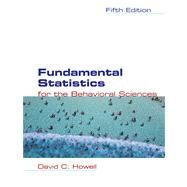Fundamental Statistics for the Behavioral Sciences (with CD-ROM and InfoTrac)
, by Howell, David C.- ISBN: 9780534399511 | 0534399517
- Cover: Hardcover
- Copyright: 6/16/2003
1. INTRODUCTION. The Importance of Context: An Example. Basic Terminology. Selection Among Statistical Procedures. Using Computers. Summary. Exercises. 2. BASIC CONCEPTS. Scales of Measurement. Variables. Random Sampling. Notation. Summary. Exercises. 3. DISPLAYING DATA. Plotting Data. Stem-and-Leaf Displays. Histograms. Reading Graphs. Alternative Methods of Planning Data. Describing Distributions. Using Computer Programs to Display Data. Summary. Exercises. 4. MEASURES OF CENTRAL TENDENCY. The Mode. The Median. The Mean. Advantages and Disadvantages of the Mode, the Median and the Mean. Obtaining Measures of Central Tendency Using MINITAB. A Simple DemonstrationSeeing Statistics. Summary. Exercises. 5. MEASURES OF VARIABILITY. Range. Interquartile Range and Other Range Statistics. The Average Deviation. The Variance. The Standard Deviation. Computational Formulae for the Variance and the Standard Deviation. The Mean and the Variance as Estimators. Boxplots: Graphical Representations of Dispersion and Extreme Scores. Obtaining Measures of Dispersion Using JMP. A Final Worked Example. Seeing Statistics. Summary. Exercises. 6. THE NORMAL DISTRIBUTION. The Normal Distribution. The Standard Normal Distribution. Setting Probable Limits on an Observation. Measures Related to z. Summary. Exercises. 7. BASIC CONCEPTS OF PROBABILITY. Probability. Basic Terminology and Rules. Discrete versus Continuous Variables. Probability Distributions for Discrete Variables. Probability Distributions for Continuous Variables. Summary. Exercises. 8. SAMPLING DISTRIBUTIONS AND HYPOTHESIS TESTING. Two Simple Examples Involving Course Evaluations and Rude Motorists. Sampling Distributions. Hypothesis Testing. The Null Hypothesis. Test Statistics and Their Sampling Distributions. Using the Normal Distribution to Test Hypotheses. Type I and Type II Errors. One- and Two-Tailed Tests. Seeing Statistics. A Final Worked Example. Back to Course Evaluations and Rude Motorists. Summary. Exercises. 9. CORRELATION. Scatter Diagrams. The Relationship Between Speed and Accuracy. The Covariance. The Pearson ProductMoment Correlation Coefficient (r). Correlations with Ranked Data. Factors That Affect the Correlation. If Something Looks Too Good To Be True, Perhaps It Is. Testing the Significance of a Correlation Coefficient. Intercorrelation Matrices. Other Correlation Coefficients. Using MINITAB and SPSS to Obtain Correlation Coefficients. Seeing Statistics. A Final Worked Example. Summary. Exercises. 10. REGRESSION. The Relationship Between Stress and Health. The Basic Data. The Regression Line. The Accuracy of Prediction. The Influence of Extreme Values. Hypothesis Testing in Regression. Computer Solution Using SPSS. Seeing Statistics. A Final Worked Example. Summary. Exercises. 11. MULTIPLE REGRESSION. Overview. Course Evaluations Again. Residuals. The Visual Representation of Multiple Regression. Hypothesis Testing. Refining the Regression Equation. A Second Example: Height and Weight. A Third Example: Psychological Symptoms in Cancer Patients. Summary. Exercises. 12. HYPOTHESIS TESTS APPLIED TO MEANS: ONE SAMPLE. Sampling Distribution of the Mean. Testing Hypotheses About Means When Ă Is Known. Testing a Sample Mean When Ă Is Unknown (The One-Sample t Test). Factors That Affect the Magnitude of t and the Decision About H0. A Second Example: The Moon Illusion. How Large Is Our Effect? Confidence Limits on the Mean. Using JMP to Run One-Sample t Tests. A Final Worked Example. Seeing Statistics. Summary. Exercises. 13. HYPOTHESIS TESTS APPLIED TO MEANS: TWO RELATED SAMPLES. Related Samples. An Example: Student's t Applied to Difference Scores. A Second Example: The Moon Illusion Again. Advantages and Disadvantages of Using Related Samples. How Large an Effect Have We Found? Using SPSS for t Tests on Related Samples. Summary. Exercises. 14. HYPOTHESIS TESTS APPLIED TO MEANS: TWO INDEPENDENT SAMPLES. Distribution of Differences Between Means. Heterogeneity






